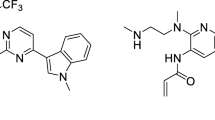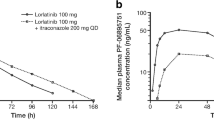Abstract
Purpose
Prevalence of non-AIDS-defining cancers (NADCs) has increased in the era of potent antiretroviral treatments. Incidence rates of NADCs now exceed AIDS-defining cancers in HIV-positive patients. Treatment of NADCs may be complicated by interactions between antiretrovirals and chemotherapy mostly via inhibition or induction of CYP3A4. Erlotinib is used to treat non-small cell lung and pancreatic cancer and is primarily metabolized by CYP3A4 into multiple products including the active metabolite (OSI-420). Preclinical in vivo assessment was performed to gain a better understanding of CYP3A4-mediated interactions between antiretrovirals and erlotinib.
Methods
Erlotinib (50 mg/kg p.o.) was administered to male FVB mice in the presence and absence of dexamethasone (10 mg/kg p.o. QDx4), efavirenz (25 mg/kg p.o. QDx4), ketoconazole (50 mg/kg p.o.), or ritonavir (12.5 mg/kg p.o.). Blood samples were collected to characterize exposure (AUC).
Results
Administration of erlotinib with CYP3A4 inducers (dexamethasone) and inhibitors (ketoconazole and ritonavir) resulted in significant alterations in erlotinib exposure. Ketoconazole and ritonavir resulted in a 1.7- and 3.0-fold increase in erlotinib AUC, respectively, while dexamethasone results in a 0.6-fold decrease in erlotinib AUC. The CYP3A4 inducer efavirenz did not have a significant effect on erlotinib exposure.
Conclusion
CYP3A4 inducers and inhibitors altered the exposure of erlotinib. Until a definitive clinical trial is performed, erlotinib should be used with caution in patients on a ritonavir-containing antiretroviral regimen, while standard doses may be appropriate for patients on an efavirenz-containing antiretroviral regimen.


Similar content being viewed by others
References
Engels EA et al (2006) Trends in cancer risk among people with AIDS in the United States 1980–2002. AIDS 20(12):1645–1654
Deeken JF et al (2012) The rising challenge of non-AIDS-defining cancers in HIV-infected patients. Clin Infect Dis 55(9):1228–1235
Mitsuyasu RT (2008) Non-AIDS-defining malignancies in HIV. Top HIV Med 16(4):117–121
Herida M et al (2003) Incidence of non-AIDS-defining cancers before and during the highly active antiretroviral therapy era in a cohort of human immunodeficiency virus-infected patients. J Clin Oncol 21(18):3447–3453
Clifford GM et al (2005) Cancer risk in the Swiss HIV Cohort Study: associations with immunodeficiency, smoking, and highly active antiretroviral therapy. J Natl Cancer Inst 97(6):425–432
Powles T et al (2009) Highly active antiretroviral therapy and the incidence of non-AIDS-defining cancers in people with HIV infection. J Clin Oncol 27(6):884–890
U.S. Department of Health and Human Services. Panel on antiretroviral guidelines for adults and adolescents. Guidelines for the use of antiretroviral agents in HIV-1-infected adults and adolescents. Department of Health and Human Services. Last updated 8 April 2015. http://aidsinfo.nih.gov/ContentFiles/AdultandAdolescentGL.pdf
Rudek MA, Flexner C, Ambinder RF (2011) Use of antineoplastic agents in patients with cancer who have HIV/AIDS. Lancet Oncol 12(9):905–912
Minuesa G et al (2011) Drug uptake transporters in antiretroviral therapy. Pharmacol Ther 132(3):268–279
Kis O et al (2010) The complexities of antiretroviral drug-drug interactions: role of ABC and SLC transporters. Trends Pharmacol Sci 31(1):22–35
Palella FJ Jr et al (1998) Declining morbidity and mortality among patients with advanced human immunodeficiency virus infection. HIV Outpatient Study Investigators. N Engl J Med 338(13):853–860
Eagling VA, Back DJ, Barry MG (1997) Differential inhibition of cytochrome P450 isoforms by the protease inhibitors, ritonavir, saquinavir and indinavir. Br J Clin Pharmacol 44(2):190–194
Cooper CL et al (2003) A review of low-dose ritonavir in protease inhibitor combination therapy. Clin Infect Dis 36(12):1585–1592
von Moltke LL et al (2001) Inhibition of human cytochrome P450 isoforms by nonnucleoside reverse transcriptase inhibitors. J Clin Pharmacol 41(1):85–91
Langer CJ (2013) Epidermal growth factor receptor inhibition in mutation-positive non-small-cell lung cancer: is afatinib better or simply newer? J Clin Oncol 31(27):3303–3306
Hirsch FR, Bunn PA Jr (2009) EGFR testing in lung cancer is ready for prime time. Lancet Oncol 10(5):432–433
Okuma Y et al (2012) Clinical characteristics of Japanese lung cancer patients with human immunodeficiency virus infection. Int J Clin Oncol 17(5):462–469
Ling J et al (2006) Metabolism and excretion of erlotinib, a small molecule inhibitor of epidermal growth factor receptor tyrosine kinase, in healthy male volunteers. Drug Metab Dispos 34(3):420–426
Pillai VC et al (2013) Ritonavir and efavirenz significantly alter the metabolism of erlotinib–an observation in primary cultures of human hepatocytes that is relevant to HIV patients with cancer. Drug Metab Dispos 41(10):1843–1851
Genetech USA, Inc. (2013) A member of the Roche Group, TARCEVA® (erlotinib) Tablets Prescribing Information, South San Francisco, CA. www.accessdata.fda.gov/drugsatfda_docs/label/2013/021743s018lbl.pdf
Petit-Jean E et al (2015) Erlotinib: another candidate for the therapeutic drug monitoring of targeted therapy of cancer? A pharmacokinetic and pharmacodynamic systematic review of literature. Ther Drug Monit 37(1):2–21
Corcos L (1992) Phenobarbital and dexamethasone induce expression of cytochrome P-450 genes from subfamilies IIB, IIC, and IIIA in mouse liver. Drug Metab Dispos 20(6):797–801
Manceau S et al (2012) Expression and induction by dexamethasone of ABC transporters and nuclear receptors in a human T-lymphocyte cell line. J Chemother 24(1):48–55
Scheer N et al (2010) In vivo responses of the human and murine pregnane X receptor to dexamethasone in mice. Drug Metab Dispos 38(7):1046–1053
Smith NF et al (2008) Modulation of erlotinib pharmacokinetics in mice by a novel cytochrome P450 3A4 inhibitor, BAS 100. Br J Cancer 98(10):1630–1632
Marchetti S et al (2008) Effect of the ATP-binding cassette drug transporters ABCB1, ABCG2, and ABCC2 on erlotinib hydrochloride (Tarceva) disposition in in vitro and in vivo pharmacokinetic studies employing Bcrp1-/-/Mdr1a/1b-/- (triple-knockout) and wild-type mice. Mol Cancer Ther 7(8):2280–2287
Rudek MA et al (2014) Combination antiretroviral therapy (cART) component ritonavir significantly alters docetaxel exposure. Cancer Chemother Pharmacol 73(4):729–736
Zhao M et al (2003) Specific method for determination of OSI-774 and its metabolite OSI-420 in human plasma by using liquid chromatography-tandem mass spectrometry. J Chromatogr B Analyt Technol Biomed Life Sci 793(2):413–420
Bailer AJ (1988) Testing for the equality of area under the curves when using destructive measurement techniques. J Pharmacokinet Biopharm 16(3):303–309
Yuan J (1993) Estimation of variance for AUC in animal studies. J Pharm Sci 82(7):761–763
Rakhit A et al (2008) The effects of CYP3A4 inhibition on erlotinib pharmacokinetics: computer-based simulation (SimCYP) predicts in vivo metabolic inhibition. Eur J Clin Pharmacol 64(1):31–41
Hamilton M et al (2014) The effect of rifampicin, a prototypical CYP3A4 inducer, on erlotinib pharmacokinetics in healthy subjects. Cancer Chemother Pharmacol 73(3):613–621
U.S. Department of Health and Human Services Food and Drug Administration/Center for Drug Evaluation and Research (2012) Guidance for industry: drug interaction studies—study design, data analysis, implications for dosing, and labeling recommendations. Draft Guidance. http://www.fda.gov/Drugs/GuidanceComplianceRegulatoryInformation/Guidances/default.htm. Accessed Feb 2015
Acknowledgments
This work is funded by contract N02-CM-62212. The project described was supported by the Analytical Pharmacology Core of the Sidney Kimmel Comprehensive Cancer Center at Johns Hopkins (NIH Grants P30 CA006973 and UL1 TR 001079, and Shared Instrument Grant 1S10RR026824-01) and Cancer Pharmacokinetics and Pharmacodynamics Facility at University of Pittsburgh Cancer Institute (P30 CA047904). Grant Number UL1 TR 001079 is from the National Center for Advancing Translational Sciences (NCATS), a component of the NIH, and NIH Roadmap for Medical Research. Its contents are solely the responsibility of the authors and do not necessarily represent the official view of the Johns Hopkins ICTR, NCATS, or NIH.
Author information
Authors and Affiliations
Corresponding author
Ethics declarations
Conflict of interest
None.
Rights and permissions
About this article
Cite this article
Deeken, J.F., Beumer, J.H., Anders, N.M. et al. Preclinical assessment of the interactions between the antiretroviral drugs, ritonavir and efavirenz, and the tyrosine kinase inhibitor erlotinib. Cancer Chemother Pharmacol 76, 813–819 (2015). https://doi.org/10.1007/s00280-015-2856-y
Received:
Accepted:
Published:
Issue Date:
DOI: https://doi.org/10.1007/s00280-015-2856-y




